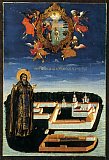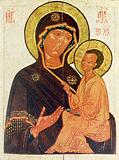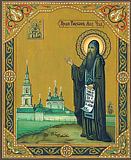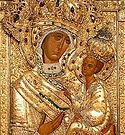

| Previous day | Next day |
| Old Style
June 26
|
Sunday |
New Style
July 9
|
|
5th Sunday after Pentecost.
Tone 4.
Fast of the Holy Apostles. |
Fish, wine and oil allowed.
|
![]() Appearance of the Tikhvin Icon of the Most Holy Theotokos (1383).
Appearance of the Tikhvin Icon of the Most Holy Theotokos (1383). ![]() St. David of Thessalonica (540).
St. David of Thessalonica (540).
St. John, bishop of Gothia in the Crimea (ca. 800). St. Dionysius, archbishop of Suzdal (1385). Uncovering of the relics of St. Tikhon of Lukhov (1569). Translation of the relics of St. Nilus of Stolobny (1995).
Icon of the Most Holy Theotokos “Of Lydda” (1st c.) Icon of the Mother of God “Neamts” (1399). and “Of the Seven Lakes” (Kazan) (17th c.).
St. Brannock (Brynach) of Braunton, England (6th c.). Martyr Pelagius of Cordoba (925). New Martyr David of St. Anne’s Skete, Mt. Athos, at Thessalonica (1813).
Thoughts for Each Day of the Year
According to the Daily Church Readings from the Word of God
By St. Theophan the Recluse

Fifth Sunday after Pentacost. [Rom. 10:1-10; Matt. 8:28-9:1]
The Gadarenes saw the Lord’s wondrous miracle, when He cast out a legion of devils, and yet, the whole city came out and besought the Lord that He would depart out of their coasts. We do not observe them relating hostilely to the Lord, but neither to we observe any faith in them. They are seized with a sort of indeterminate fearfulness, making them to desire only that the Lord pass them by, wherever He wishes, “only do not touch us.” This is a true image of people who live in peace with their possessions. An order of things has formed around them which is not unfavourable; they are used to it, they have neither thoughts nor the need to change or reverse anything, and they fear to make a new step. They feel, however, that should a command come down from above, the fear of God and their conscience would force them to renounce the old and accept something new. Therefore, they strive to avoid any circumstance which might lead them to such convictions, that they might continue living quietly in their old habits, pleading ignorance. These are the sort of people who are afraid to read the Gospels and patristic books, or to discuss spiritual matters. They fear that if their conscience be thereby disturbed, it might wake up and start forcing them to abandon what they had, and take up something else.
Articles
 Appearance of the Tikhvin Icon of the Mother of God |
 St David of Thessaloniki |
 St Dionysius the Archbishop of Suzdal |
 Venerable Tikhon of Luchov, KostromaSt Tikhon of Lukh, and Kostroma (in the world Timothy), was born within the bounds of the Lithuanian princedom and was in military service there. |
 Icon of the Mother of God of Seven LakesThe “Seven Lakes” Icon of the Most Holy Theotokos shone forth with many miracles in the seventeenth century in the area of Kazan. |






